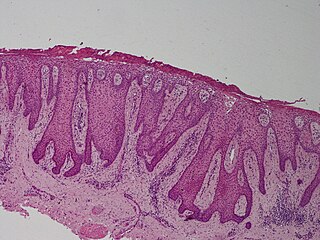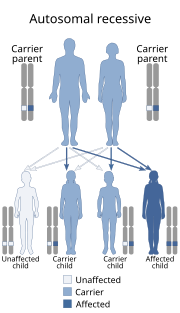SS is an abbreviation for Schutzstaffel, a former paramilitary organisation in Nazi Germany.

Pemphigus is a rare group of blistering autoimmune diseases that affect the skin and mucous membranes. The name is derived from the Greek root "pemphix," meaning "pustule."
ICD-10 is an international statistical classification used in health care and related industries.

Sweet's syndrome (SS), or acute febrile neutrophilic dermatosis is a skin disease characterized by the sudden onset of fever, an elevated white blood cell count, and tender, red, well-demarcated papules and plaques that show dense infiltrates by neutrophil granulocytes on histologic examination.
Fever of unknown origin (FUO), refers to a condition in which the patient has an elevated temperature (fever) but despite investigations by a physician no explanation has been found.
Chronic recurrent multifocal osteomyelitis (CRMO), also known as chronic recurring multifocal osteomyelitis, is a rare condition (1:6,000,000), in which the bones have lesions, inflammation, and pain. Its definition is evolving. Many doctors and articles described CRMO as an autoimmune disease that has symptoms similar to osteomyelitis, but without the infection. Some doctors thought CRMO was related to SAPHO syndrome. Research now classifies CRMO as an inherited autoinflammatory disease but have yet to isolate the exact gene responsible for it. Some specialists believe they have discovered a link between CRMO with a rare allele of marker D18S60, resulting in a haplotype relative risk (HRR) of 18. Other experts found that "mutations in LPIN2 cause a syndromic form of chronic recurrent multifocal osteomyelitis known as Majeed syndrome, while mutations in pstpip2 cause a murine form of the disorder. The roles played by LPIN2 and the human homolog of pstpip2, PSTPIP2, in the cause of chronic recurrent multifocal osteomyelitis are uncertain. The professional theories seem to be moving in the direction of an inherited gene.
Neutrophilic eccrine hidradenitis (NEH) usually is a cutaneous complication of chemotherapy, but it can also occur for other reasons. It consists of fever and non specific skin lesions. It is rare, and self-limited.

Dermatosis neglecta is a skin condition in which accumulation of sebum, keratin, sweat, dirt and debris leads to a localized patch of skin discoloration or a wart-like plaque. It is caused by inadequate hygiene of a certain body part, usually due to some form of disability or a condition that is associated with pain or increased sensitivity to touch (hyperesthesia) or immobility.
IgA pemphigus is a subtype of pemphigus with two distinct forms:

Clear cell acanthoma is a benign clinical and histological lesion initially described as neoplastic, which some authors now regard as a reactive dermatosis. It usually presents as a moist solitary firm, brown-red, well-circumscribed, 5 mm to 2 cm nodule or plaque on the lower extremities of middle-aged to elderly individuals The lesion has a crusted, scaly peripheral collarette and vascular puncta on the surface. It is characterized by slow growth, and may persist for years. The clinical differential diagnosis includes: dermatofibroma, inflamed seborrheic keratosis, pyogenic granuloma, basal cell carcinoma, squamous cell carcinoma, verruca vulgaris, psoriatic plaque, and melanoma.

Pigmented purpuric dermatosis refers to one of the three major classes of skin conditions characterized by purpuric skin eruptions.

Poikiloderma vasculare atrophicans (PVA), sometimes referred to as parapsoriasis variegata or parapsoriasis lichenoides is a cutaneous condition characterized by hypo- or hyperpigmentation, telangiectasia and skin atrophy. Other names for the condition include prereticulotic poikiloderma and atrophic parapsoriasis. The condition was first described by pioneer American pediatrician Abraham Jacobi in 1906. PVA causes areas of affected skin to appear speckled red and inflamed, yellowish and/or brown, gray or grayish-black, with scaling and a thinness that may be described as "cigarette paper". On the surface of the skin, these areas may range in size from small patches, to plaques, to neoplasms.
Rheumatoid neutrophilic dermatitis is a cutaneous condition associated with rheumatoid arthritis.

Bowel-associated dermatosis–arthritis syndrome (BADAS), is a complication of jejunoileal bypass surgery consisting of flu-like symptoms, multiple painful joints (polyarthralgia), muscle aches (myalgia) and skin changes. It has been reported to occur in up to 20% of patients who had jejunoileal bypass surgery, a form of obesity surgery that is rarely performed today.
Neutrophilic lobular panniculitis is a cutaneous condition characterized by inflammation of the subcutaneous fat.
Majeed syndrome is an inherited skin disorder characterized by chronic recurrent multifocal osteomyelitis, congenital dyserythropoietic anemia and a neutrophilic dermatosis. It is classified as an autoinflammatory bone disorder. The condition is found in people with two defective copies of the LPIN2 gene. LPIN2 encodes lipin-2 which is involved in lipid metabolism. The pathogenesis of this mutation with the clinical manifestations has not been elucidated.

Chronic Atypical Neutrophilic Dermatosis with Lipodystrophy and Elevated Temperature (CANDLE) syndrome is an autosomal recessive disorder that presents itself via various autoinflammatory responses throughout the body, multiple types of skin lesions, and recurrent long-term fever symptoms. The current known cause for the disorder is a mutation in the PSMB8 gene or mutations in other closely related genes. The syndrome was first named and classified in March 2010 after four patients were reviewed with similar symptoms. There have been approximately 30 cases ever reported in the scientific literature, as of 2015.











